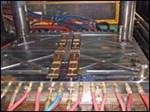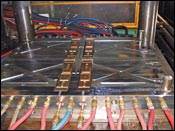A New Beryllium Standard
A proposal to set a lower exposure standard for beryllium and beryllium-containing materials will affect how the plastics industry handles and processes these materials.
To better protect industry workers, a proposal was issued in August by the U.S. Occupational Safety and Health Administration (OSHA) that would set a new, lower exposure standard specifically for beryllium and beryllium-containing materials. If this proposed standard is adopted, it will reduce OSHA’s current permissible exposure limit (PEL) for beryllium from 2.0 micrograms per cubic meter (µg/m3) to 0.2 µg/m3 as an 8-hour time-weighted average. In addition, it would create a short-term exposure limit of
2 µg/m3 for a 15-minute period and require personal protective equipment, medical exams, other medical surveillance and training.
Beryllium is a naturally occurring element which, in its pure form, is one-third lighter than aluminum yet has six times the specific stiffness of steel. When alloyed with other metals such as copper, nickel or aluminum, it improves the properties and performance of these metals. These materials offer good electrical and thermal conductivity; high strength and hardness; good corrosion and fatigue resistance; and nonmagnetic properties.
The plastics industry has long used copper beryllium alloys in plastic injection molds to increase thermal conductivity, reduce cycle times and improve plastic part quality. The adoption of a beryllium standard by OSHA has the potential to affect how these materials are handled and processed in the plastics industry.
In solid form, beryllium poses no special health risks, but exposure to airborne beryllium in the form of dust, mist or fumes can cause chronic beryllium disease (CBD) in individuals who become sensitive to beryllium. Exposure in these individuals may result in inflammation and damage to the lung tissue that may impair the lungs’ ability to transfer oxygen to the bloodstream. CBD can take months or years to develop and is sometimes fatal.
Along with a lower PEL, the proposed beryllium standard contains many requirements that are expected to improve worker safety by minimizing potential exposures. These requirements could include conducting air sampling; establishing beryllium work and regulated areas; preparing a written exposure control plan; using engineering and work practice controls to minimize worker exposures; providing workers with appropriate personal protective equipment such as gloves, clothes and respirators; providing wash and change rooms; and offering beryllium-specific education and training.
If air sampling reveals exposures higher than the permissible exposure limit, additional actions will be required, including medical surveillance, testing and possible removal from the workplace.
Once enacted into law, the new standard should provide certainty and consistency across general industry for the safe handling of beryllium. It would provide a basis for standardizing education, training, monitoring, testing and other processes, as well as help ensure the continuity of future beryllium supplies and, most importantly, help protect the health and safety of those who work with beryllium-containing materials.
OSHA has ceased accepting written public comments on the proposed beryllium standard, and will evaluate and respond to comments before issuing a final standard. This entire process can take 12 to 18 months from the time a proposed standard is issued until the time the final standard is published in the Federal Register.
Read Next
Rebuilding Tools with High Performance Material
High-performance alloy offers a unique combination of thermal conductivity and strength—providing numerous benefits to the moldmaker and molding process.
Read MoreHow to Use Continuing Education to Remain Competitive in Moldmaking
Continued training helps moldmakers make tooling decisions and properly use the latest cutting tool to efficiently machine high-quality molds.
Read MoreHow to Use Strategic Planning Tools, Data to Manage the Human Side of Business
Q&A with Marion Wells, MMT EAB member and founder of Human Asset Management.
Read More









.jpg;maxWidth=300;quality=90)








